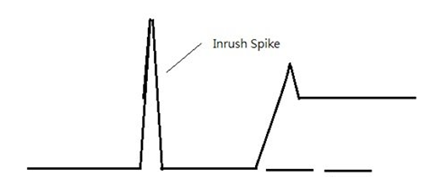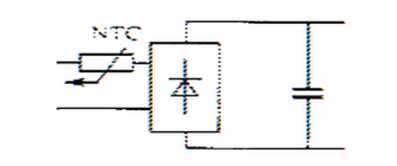Speaking of 'current', I believe everyone will not feel unfamiliar. But what is surge current? What is the relationship between it and current? Let's take a look together.
Surge current refers to the peak current that occurs in the power grid at the moment of power on or off, caused by high voltage for a short period of time and flowing into the power equipment. When certain high-capacity electrical equipment is connected or disconnected, due to the presence of inductance in the power grid, surge voltage will be generated in the power grid, resulting in surge current.

典型浪涌电流波形图
The above figure shows a typical surge current waveform. It has two peaks. The first surge tip current peak is generated when the input voltage source is started. This peak current flows into the EMI filter capacitor and the input capacitor of the DC to DC converter, and is charged to the steady-state value. The second peak current is generated when the DC to DC converter is started. This peak current flows into the output capacitor and all load capacitors through a DC DC power transformer, and is charged to the steady-state value.
Due to the rapid charging of the output filter capacitor, the peak current is much greater than the steady-state output current. Generally, regardless of the capacity of the device, there will be surge currents. Small capacity devices generate smaller surge currents and do not cause significant harm, so they are often overlooked by us. However, large-capacity electrical equipment will generate a large current, which is called surge current. The surge current is several times or even dozens of times larger than the normal current of the system, which may cause a voltage drop in the AC line, thereby affecting the normal operation of all equipment connected to the same AC line. Sometimes, it may burn out components such as fuses and rectifier diodes.
In order to avoid the impact of surge currents on our daily lives and to protect the normal use of electrical equipment. Therefore, the power supply usually limits the surge level that rectifier bridges, fuses, AC switches, and EMI filter components can withstand, so that repeated switching of the loop and AC input voltage should not damage the power supply or cause fuses to burn out.
How to measure surge current? There are currently some mature testing methods available. For example, using an R&S oscilloscope with a current probe can measure surge current. In addition, the measurement function of Chroma's AC power supply itself can be used for surge current testing. In addition, power meters or power analyzers usually have the function of testing surge currents.
Previously, we discussed the following questions: 'What is surge current? How is surge current generated? How is surge current measured. After studying in the previous chapter, we all know that surge current is generated by the rapid charging of the input filtered capacitor at the moment of power on. The surge current is much greater than the steady-state input current, so the surge current is bound to cause certain harm to us. What are the hazards of surge currents? How should we suppress surge currents? Let's take a look together.
The hazards of surge current mainly include: blown power input fuse, mechanical switch or circuit breaker adhesion failure, spark phenomenon when inserting into the socket, easy breakdown and damage of the rectifier bridge connected to the front end of the power supply, and instantaneous drop of the power grid waveform. These phenomena can bring a lot of trouble to power supply manufacturers and users, especially in situations where high reliability and safety are required. In order to avoid such phenomena, some methods must be taken to suppress surge currents.
Method for suppressing surge current:
1. Series temperature coefficient thermistor (NTC). When using the temperature coefficient to power on, the surge current is limited. After startup, the NTC flows through the current and generates heat, reducing its resistance value. This method is relatively simple, but due to the limitations of its own heating and poor hot start characteristics, it is generally only suitable for situations below 500W and with low requirements for power supply usage.

Using NTC to suppress power on surge current
2. Electromagnetic relay type, after a certain delay in power supply, the contacts of the electromagnetic relay will short-circuit the current limiting resistor. Its disadvantages are large volume, high noise generated during suction, short contact life of the relay, and poor impact vibration resistance.
3. Solid state relay type, using thyristor instead of mechanical contacts, has the disadvantage of cumbersome peripheral circuits and high bidirectional controllable leakage current, which cannot effectively control surge current.

Mechanical contact short circuiting Short circuit of electronic contacts
Surge current protection technology:
1. Transient diode (select appropriate protection voltage, unidirectional or bidirectional, absorb current), characterized by fast reaction speed and high absorption current. Usually spanning between lines or between lines and the earth.
2. Self recovery fuse, connected in series in the circuit in front of the transient diode. When the transient diode absorbs current, the current of the self recovery fuse increases and cuts off the circuit. The characteristic is that the response is slow, but it can prevent the current from continuing to increase. In the application process, appropriate voltage and current parameters should be selected
3. Air discharge tube, used for high-voltage breakdown air discharge such as lightning, is placed at the front and connected between the protective wire and the ground or between the wires.
4. The practical application of varistors, overvoltage protection wires, and bottom wires is equivalent to making a surge protector to suppress surge current.
Suppressing surge currents with resistors
Through the above learning, we know that the generation of surge currents can cause various hazards to us, whether large or small. To ensure our safety during the use of electrical appliances, we should learn and master the suppression methods of surge currents, and try to minimize this harm.